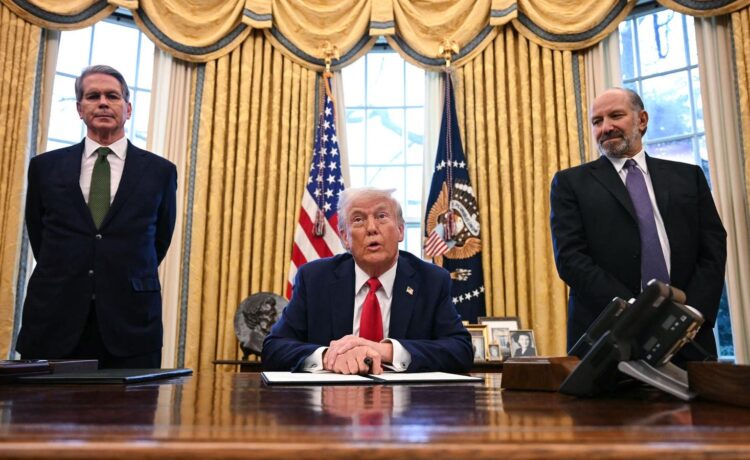President Donald Trump, alongside Secretary of Treasury Scott Bessent (L) and Secretary of Commerce … [+]
President Donald Trump signed an executive order last week, setting in motion the development of a U.S. sovereign wealth fund (SWF). The idea behind a sovereign wealth fund is that rather than relying solely on taxes or debt to finance government operations, a country can invest a portion of its national wealth in financial markets, using the returns to strengthen long-term fiscal stability.
Sovereign wealth funds have grown into major global financial institutions in recent decades. Norway’s Government Pension Fund Global, which was built on oil revenues, now holds $1.7 trillion in assets and recently recorded $222 billion in annual profits. Across the U.S., more than 20 states, including Alaska, Texas and North Dakota, have set up funds of their own, leveraging natural resource revenues to generate investment income.
The next 90 days will be crucial, as the Treasury and Commerce Departments draft a plan detailing how a federal sovereign wealth fund might be structured, funded, and managed. The key questions will revolve around what assets should be used to capitalize the fund, how investments should be selected, and what legal framework would prevent it from becoming a tool for political favoritism.
If Congress does decide to move forward with a sovereign wealth fund, it could follow several guiding principles to ensure that the fund operates effectively and serves the long-term interests of the American people.
1. Monetize Underutilized Federal Assets
To start, a U.S. sovereign wealth fund should be self-financed rather than built on tax revenue or government borrowing. The federal government holds vast reserves of land, mineral rights, and infrastructure assets that are not generating their full potential economic value. By leasing or selling portions of these assets—such as offshore drilling rights, federal buildings, or unused real estate—the government could generate substantial capital to seed the fund.
2. Keep Investments International
For a U.S. sovereign wealth fund to succeed, it should steer clear of direct investments in U.S. companies. Governments playing an active role in domestic markets can distort competition, introduce political favoritism, and create conflicts of interest. A fund focused on global markets, particularly in fast-growing developing economies, would offer higher potential returns while avoiding the risk of becoming entangled in domestic business decisions.
3. Maintain a Passive Investment Approach
To prevent the fund from becoming a politicized investment vehicle, it should operate as a passive investor, much like Norway’s model. This means avoiding majority ownership stakes in corporations and staying out of corporate governance decisions. Rather than attempting to steer companies in a particular direction, the fund should focus solely on maximizing returns for the long-term benefit of U.S. taxpayers.
4. Establish Clear Investment Goals and Performance Benchmarks
A sovereign wealth fund should have a well-defined purpose, guiding how assets are managed and measured for success. Clear investment goals will help ensure disciplined decision-making, while a benchmark rate of return will provide a standard for evaluating performance. The fund should seek to earn as high a return as possible given the level of risk it is willing to take, maintaining a diversified portfolio that supports long-term growth without exposing assets to unnecessary volatility. By setting clear expectations, the fund can remain focused on financial sustainability.
5. Use a Portion of Returns to Reduce National Debt
The U.S. faces an ever-growing national debt burden, and a well-managed sovereign wealth fund could help ease that pressure. By dedicating a portion of annual investment earnings toward debt reduction, the fund could contribute to the long-term fiscal health of the nation. This approach would mirror how some state investment funds use their proceeds to stabilize budgets and finance essential programs without increasing taxes.
6. Shield the Fund from Political Influence
Norway’s Government Pension Fund Global is the largest sovereign wealth fund in the world.
Political interference is a risk for any sovereign wealth fund. To avoid this, the fund should be governed by an independent board. Strong legal protections should ensure that the fund’s management remains insulated from shifting administrations and congressional spending pressures. The goal should be financial discipline, not short-term political gain.
7. Invest In Long-Term, High-Risk Ventures
Governments have unique advantages when it comes to investing in frontier technologies and industries with long development cycles. A portion of the fund could be dedicated to high-risk, high-reward ventures—areas where the private sector is often hesitant to commit resources. This might include cutting-edge energy projects, artificial intelligence, or next-generation infrastructure, ensuring that the U.S. remains at the forefront of innovation and taxpayers capture their fair share of the returns.
8. Ensure Transparency and Public Accountability
Public trust in the fund’s management is essential. That means regular audits, clear reporting requirements, and strict oversight mechanisms should be built into its governance structure. Annual reports to Congress, independent financial audits, and open investment disclosures would help ensure the fund remains a responsible steward of public wealth.
9. Limit Congressional Withdrawals to Preserve Growth
One of the biggest threats to sovereign wealth funds is political overreach, where governments deplete assets for immediate spending needs. To prevent this, a strict withdrawal cap should be established, limiting spending from the fund to no more than, for example, 5% of its value over a two-year period—similar to North Dakota’s Legacy Fund model. This would ensure that the fund continues to grow over time rather than becoming a budget stopgap.
A Strategic Opportunity—If Done Right
The idea of a U.S. sovereign wealth fund is ambitious, but not without precedent. Many of the world’s wealthiest nations—Norway, China, Saudi Arabia, and Kuwait—have used these funds to secure their economic futures. Within the U.S., states like Alaska and North Dakota have demonstrated how resource revenues can be transformed into long-term financial assets.
If structured properly, a U.S. sovereign wealth fund could help reduce reliance on debt, stabilize the federal budget, and generate lasting wealth for generations to come. However, without clear financial discipline and strong governance safeguards, it risks becoming a tool for political spending.
As the administration’s plan takes shape over the coming months, the critical question will be whether Washington can resist the temptation to turn an investment vehicle into a short-term spending spree. If the fund is guided by sound financial principles and managed independently, it could be a game-changer for U.S. fiscal policy. Otherwise, it may end up as just another political experiment that falls short of its potential.





